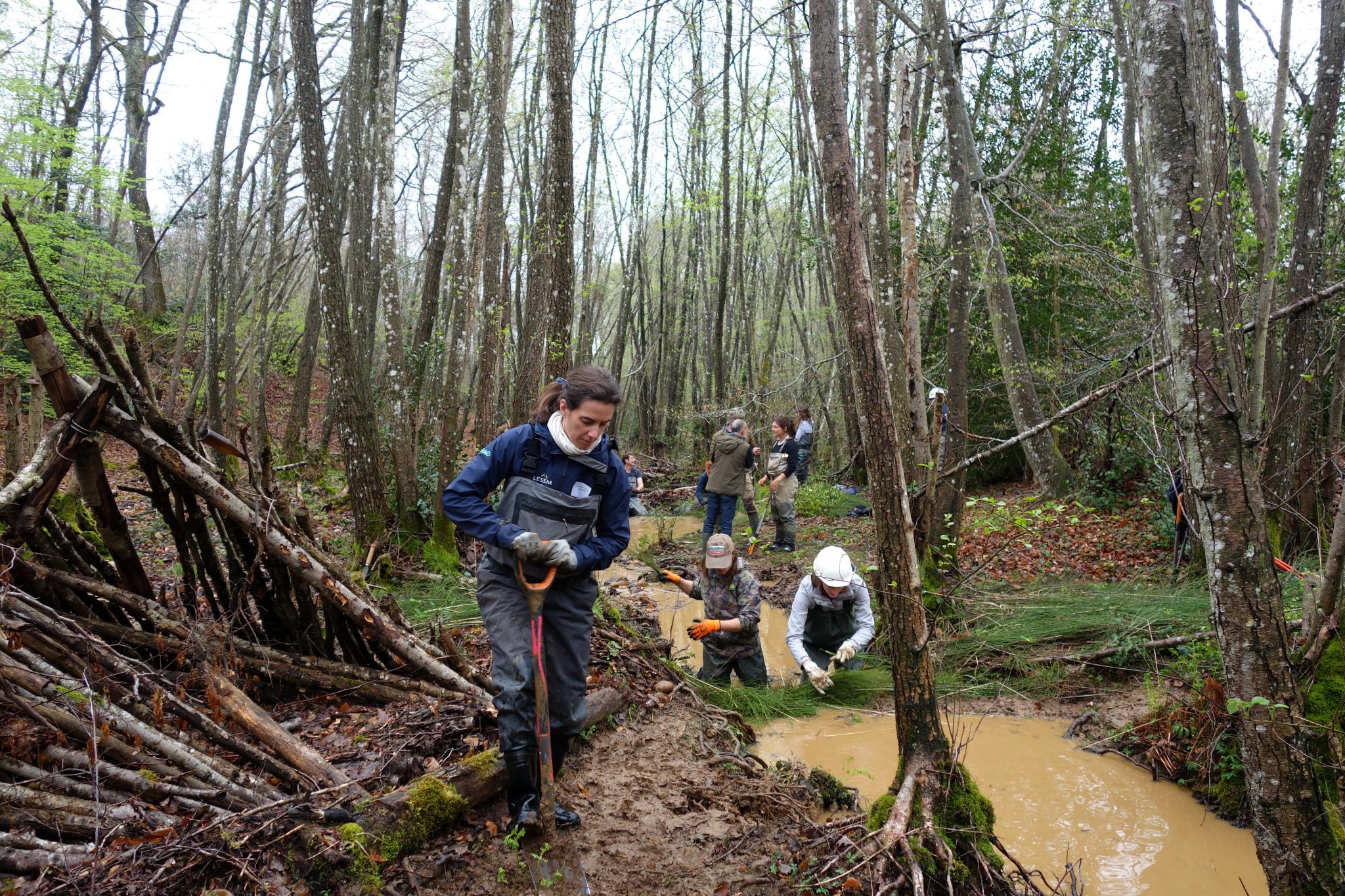A team of participants bring process-based restoration to the Savasse uplands of the Chalon watershed, hosted by Association Rivière Rhône Alpes Auvergne (ARRA²)
This spring, Occidental Art & Ecology Center WATER Institute Co-Director Kate Lundquist and her partner Kevin Swift of Swift Water Design returned to France to offer process-based restoration trainings, building significantly upon last year’s similar collaboration. Suzanne Husky and co-founders from Mouvement d’Alliance avec le Peuple Castor (MAPCa) once again expertly organized a coalition of collaborators, including 150 practitioners, nonprofit partners, and policy-makers who each came to learn about beaver and process-based restoration (PBR) across France.
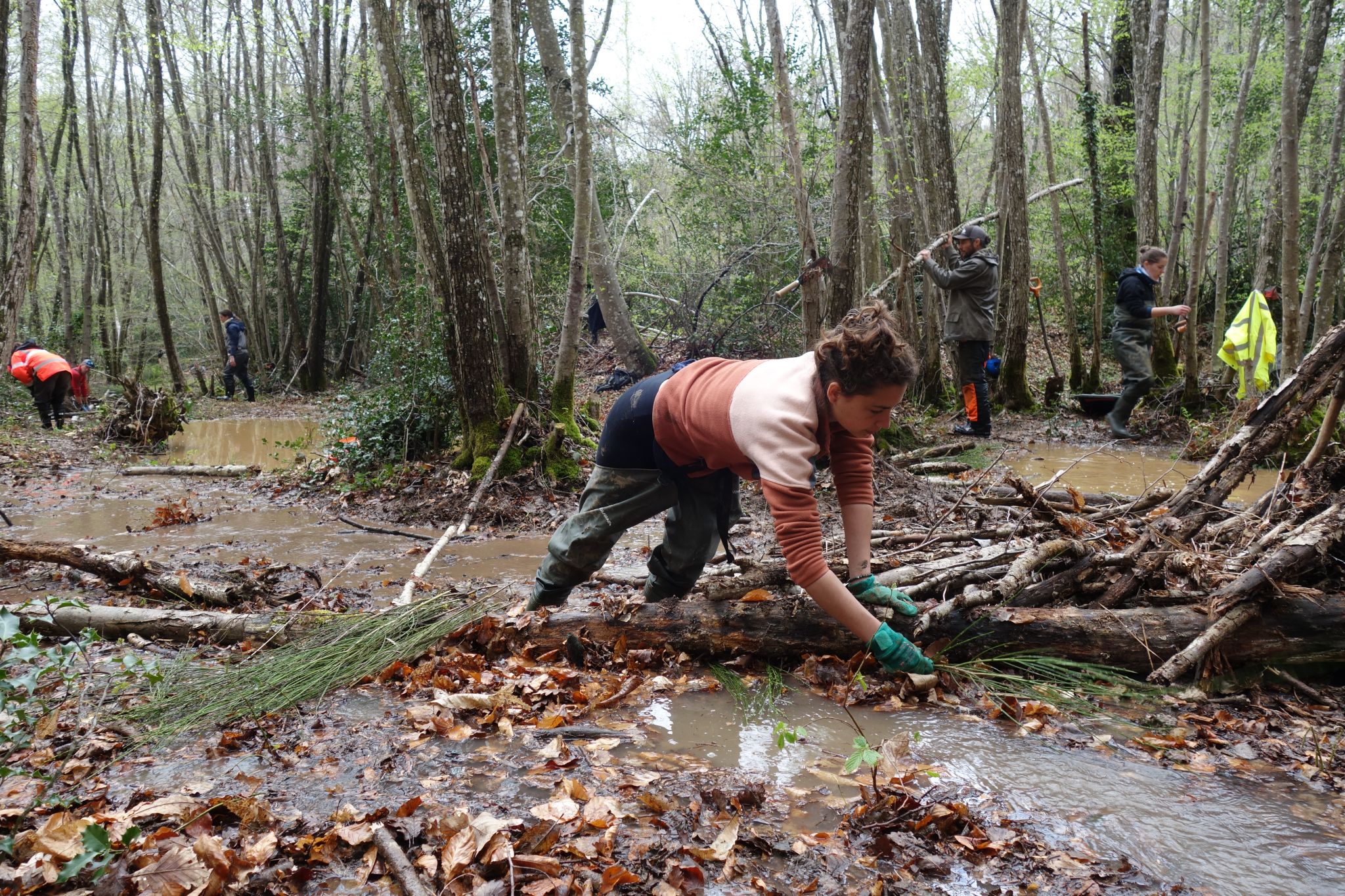
In the Savasse uplands, process-based restoration structures will support water storage in a unique geological formation called molasse, which can retain water for upwards of 10,000 years. Photo: Nathalie Perrin of Association Association Rivière Rhône Alpes Auvergne (ARRA²)
After last year’s trainings, many participants shared that they felt inspired to effect change and ready to integrate PBR in their work. Cut to this year, the movement has gained significant momentum, with a notable increase in regulators and decision-makers embracing these innovative restoration techniques as a serious and viable strategy. In the past year, ongoing community-led organizing, Suzanne and Baptiste Morizot‘s inspiring and informative new book, Rendre L’Eau á la Terre (Returning Water to the Earth), and trainings like this one, have each led to continued enthusiasm for using “medecine castor” (beaver medicine) to restore rivers in France.
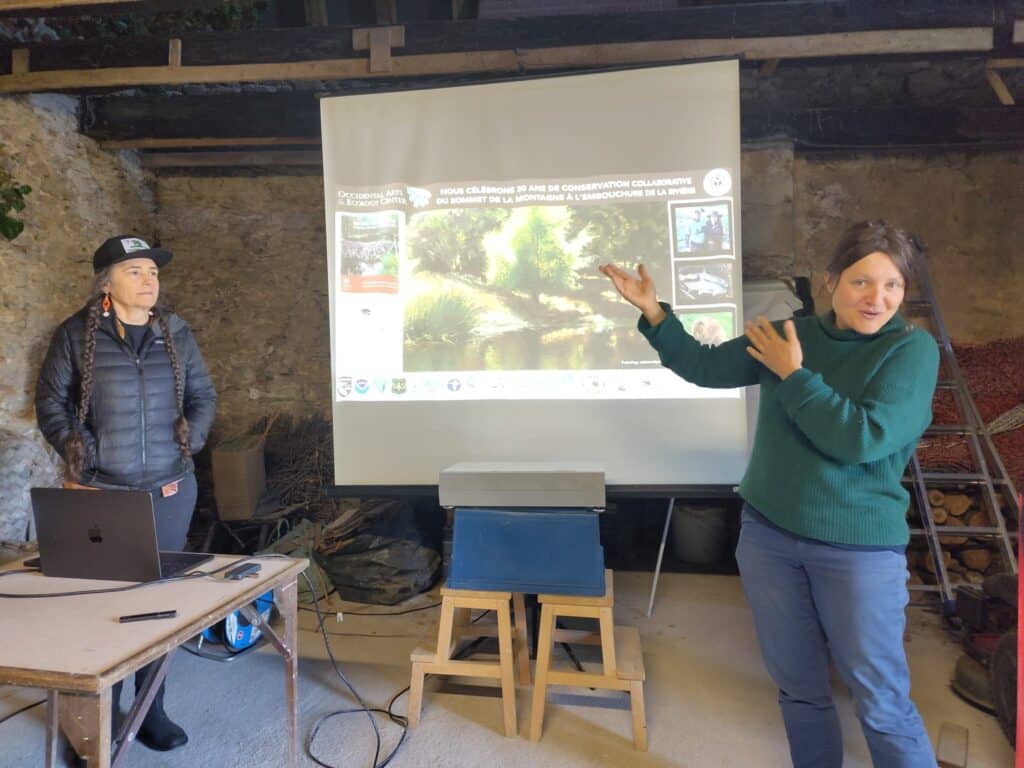
(above) Artist and beaver advocate Suzanne Husky presents about the importance of beaver in local watersheds, alongside Kate Lundquist, WATER Institute Co-Director.
Suzanne, Baptiste, and Clément Délis, and Brice Le Maire from Mouvement d’Alliance avec le Peuple Castor (MAPCa), brought together a coalition of landowners, river technicians, agriculturists, regulators, and conservation agencies to practice together while learning from Kate and Kevin’s Californian perspectives on PBR, opening up conversations about pathways that could work in a French context as well.
“There are a lot of similarities between France and California,” shared Kate. “The list is long: historic agricultural traditions, iconic rivers, industrialized streamlining of waterways to the point of collapse, the extirpation of salmon and beavers, and the more recent realization that beaver stewardship and mimicry greatly support watershed health. There is much we can learn from one another.”
Learning together, sharing eco-literacy, and building practical restoration capacity are all part of the WATER Institute’s approach. Of this style of exchange, WATER Institute Co-Director Brock Dolman shares: “It’s literally a lot of dirt under the nails and a lot of lower back; it’s conviction, transparency, humility, and experience to say: ‘well, we tried this and that worked or that didn’t, we’re adapting or we would do this differently next time.’ It’s the humility of being in a community of practice that’s literally on the cutting edge, whether that cutting edge is a pair of loppers or a chainsaw.”
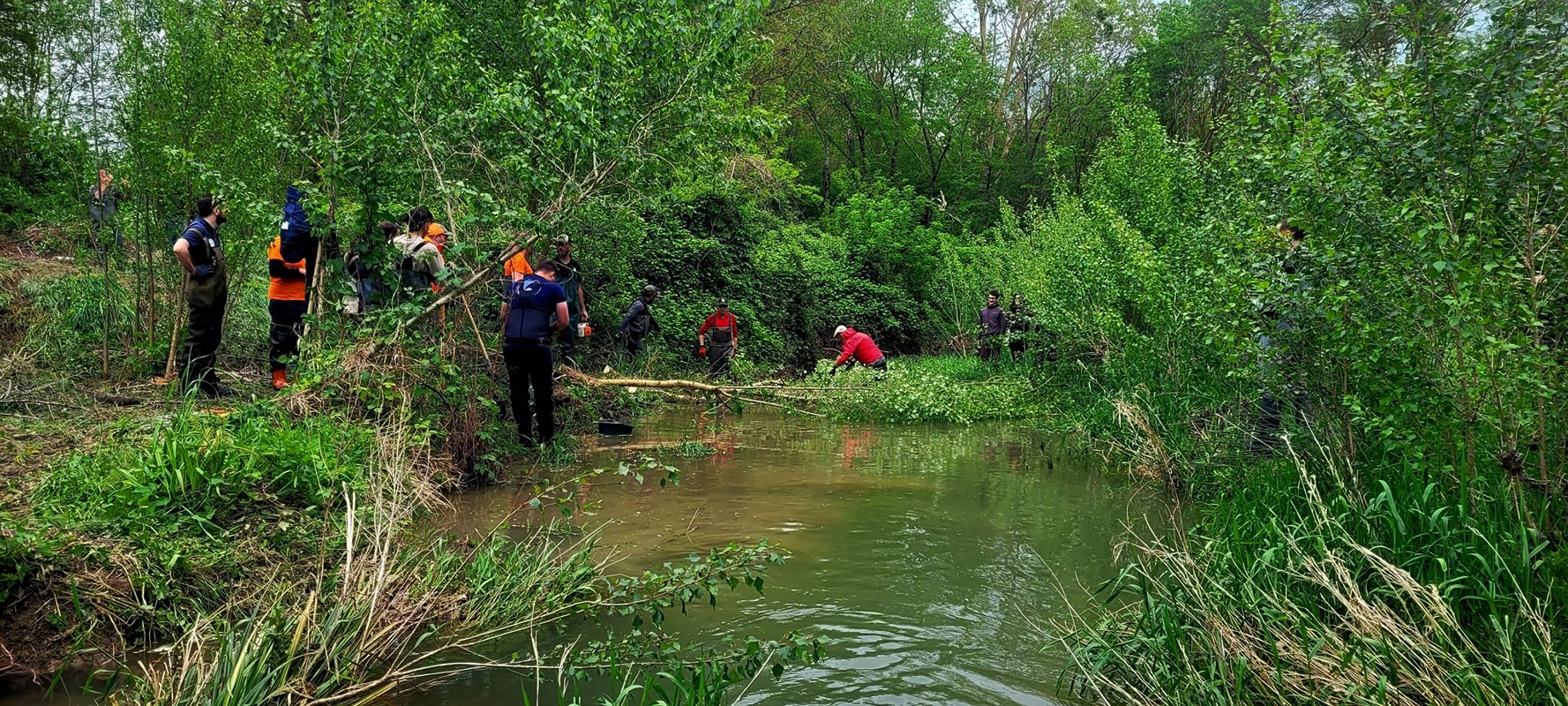

(left) French trainees construct an in-stream structure in the Aude watershed, hosted by Syndicat Mixte des Milieux Aquatiques et des Rivières (SMMAR). Photo by: Hélène Mathieu-Subias
(right) Jake Kowalick of Swift Water Design on the left, demonstrates to French trainees how to prepare materials for building postless beaver dam analogs on a sub-tributary of the Chalon River. Looking on from left to right are French trainee, Kate Lundquist of OAEC, Kevin Swift of Swift Water Design, Suzanne Husky of MAPCa, and Charlène Descollonges. Photo: Association Association Rivière Rhône Alpes Auvergne (ARRA²)
During Kate and Kevin’s three-and-a-half-week long trip, they led a series of six trainings across three regions of France. They brought that ethos of the humble cutting edge by sharing an innovative, practical, and collaborative approach to restoration design and implementation, demonstrating techniques such as postless beaver dam analogs and post-assisted log structures and then working with participants to build them.
On the first stop, in the agricultural Aquitaine region, participants worked on small upland stream channels at Astrid and Mathieu Puel’s Les Fermes de Segur. In recent years, wildfire affected a wildlife preserve in nearby Bordeaux, so like the WATER Institute’s Fuels to Flows campaign, there was an opportunity to take care of densely stocked upland forests, using products from limbing and thinning to build in-stream structures. These treatments will ultimately pool water, create floodplain connectivity, provide more forage for livestock, support habitat, and produce wetter, spongier floodplain soils that sequester carbon, in short, realizing multiple restoration goals at once.

MAPCa’s Suzanne Husky, on the left, and OAEC’s Kate Lundquist, in the middle, wearing a hard hat, demonstrate to French trainees how to build a postless beaver dam analog in a side tributary of the Chalon River in the Drôme region of the French Alps foothills. Photo by: Association Association Rivière Rhône Alpes Auvergne (ARRA²)
The second training site was located in the Drôme Department in the foothills of the Alps along two points of the Chalon watershed. MAPCa worked with the Association Rivière Rhône Alpes Auvergne (ARRA²) to expertly host two trainings based out of the eco-agricultural retreat center Terre-a-Terre run by Marilyne and Vincent Thevenin and family. During these trainings, the mainstem system reached high flows, and everyone got to see how well the structures performed with more water in them. In the Savasse uplands, the team worked in-stream to encourage extra water storage in the molasse geological formation that is prevalent in this area.
While in the Drôme area, Kate, Kevin and Suzanne were honored to be invited by Pascal Laussal to contribute to a round-table discussion on beaver restoration as part of a sold out day-long Encounters With Beavers event hosted by French environmental conservation organization Dryade in the town of Chabrillan.
In Southern France in the Aude watershed, the OAEC, Swift Water Design and MAPCa team was hosted by Mathieu Dupuis and Hélène Mathieu-Subias of the Syndicat Mixte des Milieux Aquatiques et des Rivières (SMMAR). Their charge was to design and implement a project that could help address the Mediterranean extremes of weather whiplash as seen in recent catastrophic flooding that has taken lives and reconfigured channels and towns. Participants worked on a sub-tributary of the Sou River to build more resilient floodplains.

Hélène Mathieu-Subias, SMMAR’s technical director working in the Aude watershed, reflected that during these trainings she witnessed neighbors supportively talking about the work being done, and at the end of the training, she noted her belief that river regulations would evolve given how many ecological and economic benefits process-based restoration brings with it. The event was well-received by the French press as well.

(above) The team gathers for in-stream learning in the Aude watershed, hosted by Syndicat Mixte des Milieux Aquatiques et des Rivières (SMMAR). (bottom) The SMARR team continues work on the lasagna layer technique, utilizing branches and soil to build a beaver-like structure. Photos by: Hélène Mathieu-Subias
As far as French river regulations go, it is still illegal to introduce or sustain wood into river systems. This law is a holdover from when aristocratic mill owners required this material, be removed to prevent damage to mill infrastructure. But even since last year’s visit, Kate has noticed shifts in French regulator’s willingness to work with restoration professionals to issue experimental permits to allow this important woody material back into river systems. One example of this teamwork is Cédric Cadet, an aquatic environments and wetlands management professional who helped MAPCa permit many of this year’s projects.
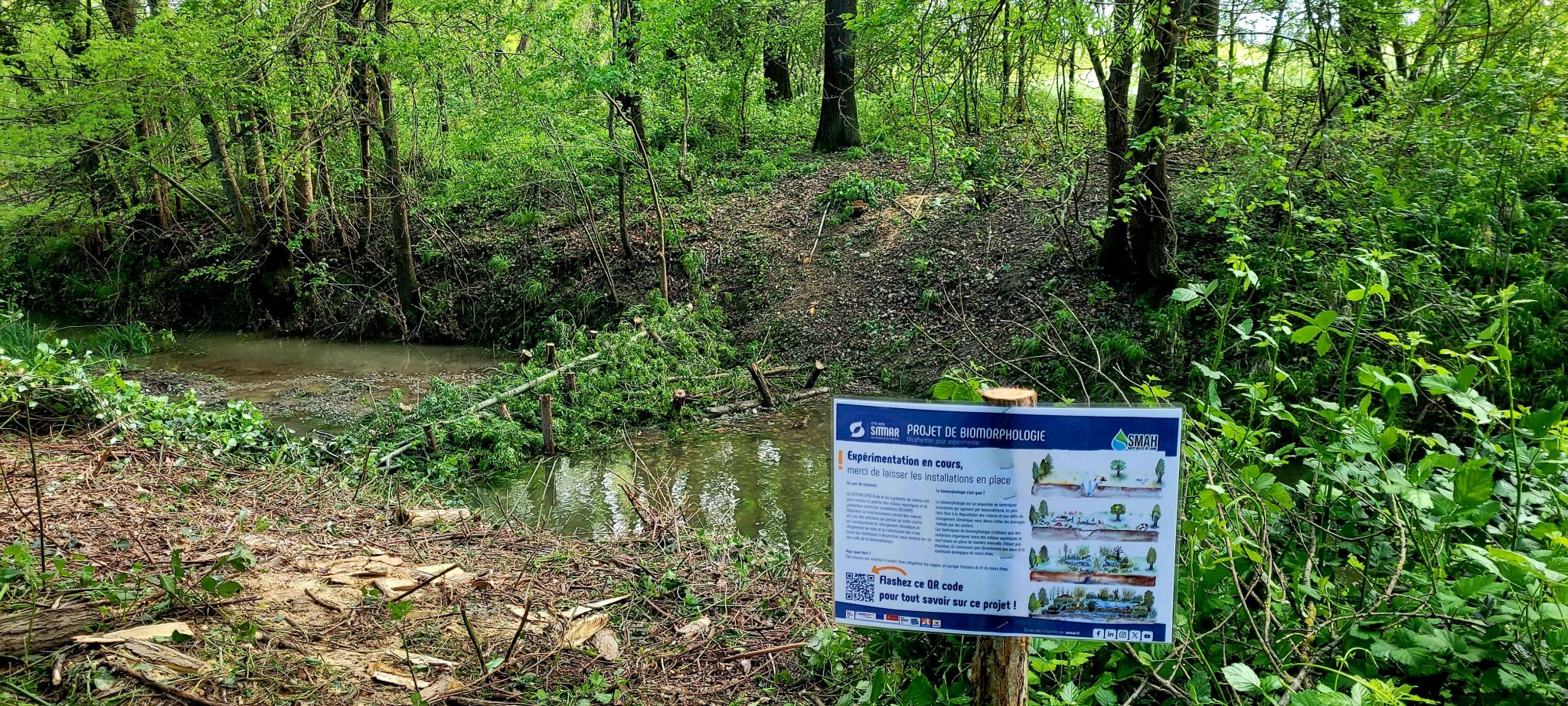
A bank-attached post-assisted log structure induces a meander in the Sou River (Aude watershed) next to signage featuring Suzanne Husky’s artwork which demonstrates the benefits of beaver and considers beaver as important community members.
Photo by: Hélène Mathieu-Subias
Essentially, the trainings led by Kate and Kevin allow French practitioners to fast forward on the timeline, to learn about the long view of watersheds restored with process-based restoration. California once had its own stream cleaning guidelines, and it was only in the 1980s that the state recognized that removing wood from streams was actually starving them of critical habitat and the development of healthy channel processes.
The WATER Institute is committed to offering trainings, when invited, to individuals who will share and multiply this knowledge in their communities. Just as climate change knows no bounds, trainings like these work beyond borders, bringing allies together to pool knowledge, resources, and literal water. “It’s PBR without borders,” shared Brock, who went on to say: “We want to really rethink and retrofit all human settlement for resilience, with water as the central guide to our success.”
After another successful training with our French collaborators, we are grateful for the ongoing collaboration, community participation, and visionary organizing that ensures the continuity of watershed-scale restoration. We look forward to seeing what emerges from this continued momentum and ongoing partnership in France.
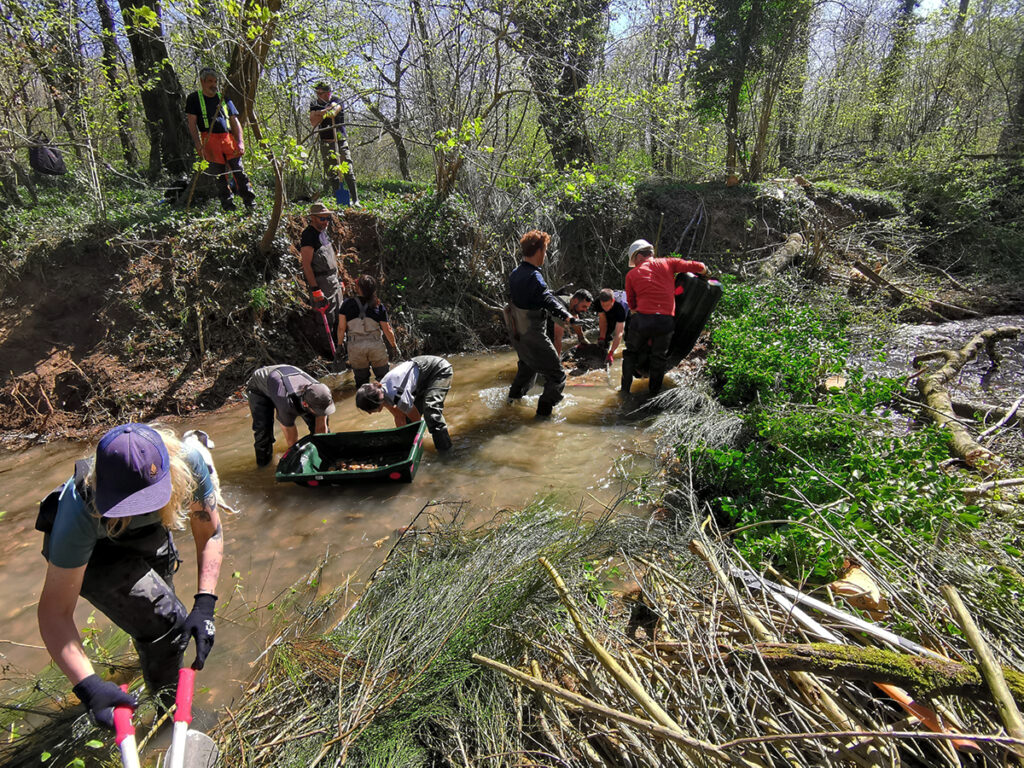
The team continues building in-stream structures along the Chalon River in the foothills of the French Alps. Photo by: Association Association Rivière Rhône Alpes Auvergne (ARRA²)
